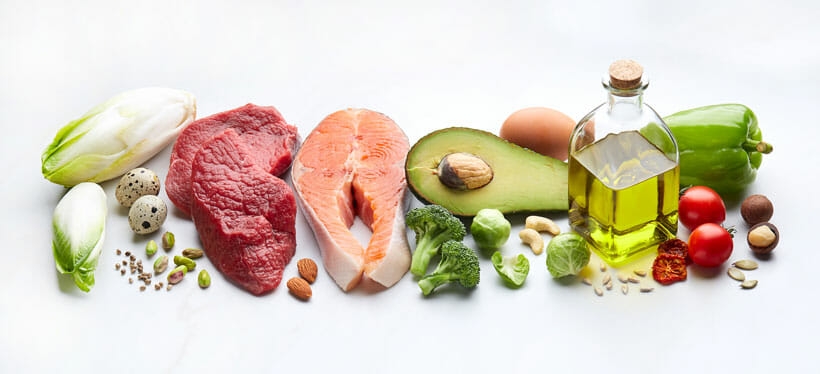What is the Ketogenic Diet?
Historically, the Ketogenic diet was discovered as early as the 20th century and was (yet still is) an effective solution for individuals suffering from epilepsy. In the early times, bodybuilders used to apply it without knowing the mechanisms behind it by doing a “fish and water” diet. Additionally, it is the diet that humans historically adhered to naturally before processed sugars became so readily available.
To date, the Ketogenic Diet has maintained its status of effectiveness and of course gained wider attention among people looking to lose weight faster. The Ketogenic diet is a low-carb, high-fat diet that causes weight loss and provides health benefits. It involves significantly reducing carbohydrate intake while increasing protein to the levels necessary to maintain muscle mass, with the calorie ratios approximating 70 percent fat, 25 percent protein, and 5 low-glycemic carbohydrates.
How Does the Ketogenic Diet Work?
Attaining ketosis is straightforward; however, it can seem difficult and confusing with all the information out there. The general dietary guidelines of the Ketogenic Diet involve avoidance of high carbohydrate foods such as bread, pasta, potatoes, rice, etc. as well as all simple carbohydrates such as sugar, honey, and fruit juice.
Protein is included in every meal as this helps to reduce appetite, regulate blood glucose levels and preserve lean muscle mass. Examples of protein foods are fish, chicken, turkey, meat, eggs, and cheese. Protein drinks such as whey protein isolate may be utilized.
Adequate fat intake is essential as this enhances fat burning by the body while reducing the synthesis of fatty acids in the body, which both promote fat loss. Optimal sources of fats are fatty meats, fish, avocado, olive oil, nuts, and seeds.
There are numerous benefits that come with being on Ketogenic Diet: from weight loss and increased energy levels to therapeutic medical applications. Almost anyone can safely benefit from eating a low-carb, high-fat diet.
FOODS TO EAT
- Vegetables (excluding starchy vegetables)
- Leafy Greens
- Meat (Beef, Lamb, Poultry, Eggs, and Fish)
- High Fat Dairy (Hard Cheeses, High Fat Cream, Butter, etc.)
- Nuts & Seeds (Macadamias, Walnuts, Sunflower seeds, etc.)
- Oil & Fats (Coconut Oil, Olive Oil, Avocado Oil, Bacon Fat)
- Sweeteners (Stevia, Erythritol, Monk fruit, etc.)
FOODS TO AVOID
- Grains (Wheat, Corn, Rice, Cereal, etc.)
- Fruits
- Starchy Vegetables (Sweet Potatoes and Squashes)
- Sugars (Honey, Agave, Maple Syrup, etc.)

What is the Keto Flu?
The Keto flu, which is otherwise known as ‘carb flu’ by many, is used to describe the flu-like reactions that often follow the commencement of a ketogenic diet. It happens as a result of the sudden and drastic removal of carbs from your diet.
One of the major reasons you get this flu is a result of insufficient electrolytes in your diet. These electrolytes include calcium, sodium, potassium, and magnesium. When you made the diet switch, you also cut down on the richest electrolyte sources such as starchy fruits and vegetables, which may result in the different symptoms you experience.
The Keto flu usually doesn’t take long, a week or less for an average person. But it can also last up to two to four weeks in some individuals. How long the keto-flu will last often depends on some factors.
If your diet has always been high in processed foods and refined sugar, it’s more likely you have more experience with the symptoms. And this can also depend on the genetic make-up of the individual as some people tend to be more metabolically flexible, making it easier for them to shift between diets.
Keto flu symptoms may be very undesirable, yet it’s worth it. Don’t allow it to stop you from getting all the health benefits embedded in the ketogenic diet, so do everything you can to make sure you don’t go out of ketosis.
Symptoms of the Keto Flu
- HEADACHES
- DIZZINESS
- SUGAR CRAVINGS
- DIFFICULTY FALLING ASLEEP
- NAUSEA
- STOMACH UPSET
- BRAIN FOG
- CRAMPING
- FATIGUE
How to Manage Keto Flu Symptoms
- STAY HYDRATED
- TAKE AN ELECTROLYTE SUPPLEMENT
- EAT MORE FATS
- ENGAGE IN LIGHT EXERCISE

